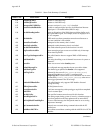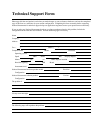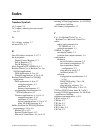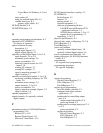
© National Instruments Corporation Index-1 PC-OPDIO-16 User Manual
Index
Numbers/Symbols
+5 V signal, 3-3
24 V inputs, reducing forward current
for, 3-8
A
AC voltages, sensing, 3-7
advanced VIs, 5-5
B
base I/O address selection, 2-2, C-1
bit descriptions
Digital Control Register, C-3
Port A Register, C-2
Port B Register, C-3
block diagram of PC-OPDIO-16, 5-1
Borland Turbo C++ or Borland C++, for
NI-DAQ applications
DOS applications, 4-5 to 4-6
Windows applications, 4-9 to 4-10
Borland Turbo Pascal, for NI-DAQ
applications
DOS applications, 4-6 to 4-7
example programs, 4-7
guidelines, 4-6
memory requirements, 4-7
programming considerations for
NI-DAQ functions, 6-3
Windows applications, 4-11 to 4-13
example programs, 4-12
guidelines, 4-11 to 4-12
special considerations, 4-12 to 4-13
using NI-DAQ functions, 6-3
buffer allocation for NI-DAQ Windows
programming, 4-8 to 4-9
Borland C++, 4-10
Borland Turbo Pascal, 4-12
Microsoft Visual Basic, 4-14 to 4-15
building NI-DAQ applications. See NI-DAQ
applications, building.
bus-related configuration, 2-2
C
C++. See Borland Turbo C++ or
Borland C++; Microsoft Visual C++.
cables
cables and connectors for
PC-OPDIO-16, 1-4
optional equipment, 1-3
COM<0..7> signal
description (table), 3-3
isolation from output channels, 3-4
configuration
hardware
base I/O address selection, 2-2
bus-related configuration, 2-2
data acquisition-related
configuration, 2-3
plug and play mode, 2-2
switchless mode, 2-2
software
configuration considerations, 2-5
to 2-6
DAQCONF utility, 2-6 to 2-8
overview, 2-5
plug and play software, 2-6
WDAQCONF utility, 2-8 to 2-9
CP Clare LDA210 data sheet, B-1 to B-3
creating NI-DAQ applications. See NI-DAQ
applications, building.
customer communication, xi, E-1
CW<6..4> bits, C-3
CW0 bit, C-3
CW1 bit, C-3
CW2 bit, C-3
CW3, 0 bits, C-3
CW7 bit, C-3


















